Description
Indications and usage
To reduce the development of drug-resistant bacteria and maintain the effectiveness of LEE-FLOX and other antibacterial drugs, LEE-FLOX should be used only to treat or prevent infections that are proven or strongly suspected to be caused by susceptible bacteria. When culture and susceptibility information are available, they should be considered in selecting or modifying antibacterial therapy. In the absence of such data, local epidemiology and susceptibility patterns may contribute to the empiric selection of therapy.LEE-FLOX Tablets are indicated for the treatment of adults (≥18 years of age) with mild, moderate, and severe infections caused by susceptible strains of the designated microorganisms in the conditions listed below.
Culture and susceptibility testing
Appropriate culture and susceptibility tests should be performed before treatment in order to isolate and identify organisms causing the infection and to determine their susceptibility to levofloxacin. Therapy with LEE-FLOX may be initiated before results of these tests are known; once results become available, appropriate therapy should be selected. As with other drugs in this class, some strains of Pseudomonas aeruginosa may develop resistance fairly rapidly during treatment with LEE-FLOX. Culture and susceptibility testing performed periodically during therapy will provide information about the continued susceptibility of the pathogens to the antimicrobial agent and also the possible emergence of bacterial resistance.
1- Nosocomial Pneumonia: LEE-FLOX is indicated for the treatment of nosocomial pneumonia due to methicillin-susceptible Staphylococcus aureus, Pseudomonas aeruginosa, Serratia marcescens, Escherichia coli, Klebsiella pneumoniae, Haemophilus influenzae, or Streptococcus pneumoniae. Adjunctive therapy should be used as clinically indicated. Where Pseudomonas aeruginosa is a documented or presumptive pathogen, combination therapy with an anti-pseudomonal β-lactam is recommended.
2- Community-Acquired Pneumonia: (7–14 day Treatment Regimen) LEE-FLOX is indicated for the treatment of community-acquired pneumonia due to methicillin-susceptible Staphylococcus aureus, Streptococcus pneumoniae (including multi-drug-resistant Streptococcus pneumoniae [MDRSP]), Haemophilus influenzae, Haemophilus parainfluenzae, Klebsiella pneumoniae, Moraxella catarrhalis, Chlamydophila pneumoniae, Legionella pneumophila, or Mycoplasma pneumoniae. MDRSP isolates are strains resistant to two or more of the following antibacterials: penicillin , 2nd generation cephalosporins, e.g., cefuroxime, macrolides, tetracyclines and trimethoprim/sulfamethoxazole.
3- Community-Acquired Pneumonia: (5-day Treatment Regimen) LEE-FLOX is indicated for the treatment of community-acquired pneumonia due to Streptococcus pneumoniae (excluding multi-drug-resistant strains [MDRSP]), Haemophilus influenzae, Haemophilus parainfluenzae, Mycoplasma pneumoniae, or Chlamydophila pneumoniae.
4- Acute Bacterial Sinusitis: (5-day and 10–14 day Treatment Regimens) LEE-FLOX is indicated for the treatment of acute bacterial sinusitis due to Streptococcus pneumoniae, Haemophilus influenzae, or Moraxella catarrhalis.
5- Acute Bacterial Exacerbation of Chronic Bronchitis: LEE-FLOX is indicated for the treatment of acute bacterial exacerbation of chronic bronchitis due to methicillin-susceptible Staphylococcus aureus, Streptococcus pneumoniae, Haemophilus influenzae, Haemophilus parainfluenzae, or Moraxella catarrhalis.
6- Complicated Skin and Skin Structure Infections: LEE-FLOX is indicated for the treatment of complicated skin and skin structure infections due to methicillin-susceptible Staphylococcus aureus, Enterococcus faecalis, Streptococcus pyogenes, or Proteus mirabilis.
7- Uncomplicated Skin and Skin Structure Infections: LEE-FLOX is indicated for the treatment of uncomplicated skin and skin structure infections (mild to moderate) including abscesses, cellulitis, furuncles, impetigo, pyoderma, wound infections, due to methicillin-susceptible Staphylococcus aureus, or Streptococcus pyogenes.
8- Chronic Bacterial Prostatitis: LEE-FLOX is indicated for the treatment of chronic bacterial prostatitis due to Escherichia coli, Enterococcus faecalis, or methicillin-susceptible Staphylococcus epidermidis.
9- Complicated Urinary Tract Infections:(5-day Treatment Regimen) LEE-FLOX is indicated for the treatment of complicated urinary tract infections due to Escherichia coli, Klebsiella pneumoniae, or Proteus mirabilis.
10- Complicated Urinary Tract Infections:(10-day Treatment Regimen) LEE-FLOX is indicated for the treatment of complicated urinary tract infections (mild to moderate) due to Enterococcus faecalis, Enterobacter cloacae, Escherichia coli, Klebsiella pneumoniae, Proteus mirabilis, or Pseudomonas aeruginosa.
11- Acute Pyelonephritis: (5 or 10-day Treatment Regimen) LEE-FLOX is indicated for the treatment of acute pyelonephritis caused by Escherichia coli, including cases with concurrent bacteremia.
12- Uncomplicated Urinary Tract Infections: LEE-FLOX is indicated for the treatment of uncomplicated urinary tract infections (mild to moderate) due to Escherichia coli, Klebsiella pneumoniae, or Staphylococcus saprophyticus.
13- Inhalational Anthrax (Post-Exposure): LEE-FLOX is indicated for inhalational anthrax (post-exposure) to reduce the incidence or progression of disease following exposure to aerosolized Bacillus anthracis. The effectiveness of LEE-FLOX is based on plasma concentrations achieved in humans, a surrogate endpoint reasonably likely to predict clinical benefit. LEE-FLOX has not been tested in humans for the post-exposure prevention of inhalation anthrax. The safety of LEE-FLOX in adults for durations of therapy beyond 28 days or in pediatric patients for durations of therapy beyond 14 days has not been studied. Prolonged LEE-FLOX therapy should only be used when the benefit outweighs the risk.
Dosage and administration
- Dosage in adult patients with normal renal function
The usual dose of LEE-FLOX Tablets is 250 mg, 500 mg, or 750 mg administered orally every 24 hours, as indicated by infection and described below.These recommendations apply to patients with creatinine clearance ≥ 50 mL/min. For patients with creatinine clearance <50 mL/min, adjustments to the dosing regimen are required.
Dosage in Adult Patients with Normal Renal Function (creatinine clearance ≥ 50mL/min)
| Type of infection | Dosed every 24 hours | Duration (days) |
| Nosocomial pneumonia | 750 mg | 7-14 |
| Community acquired pneumonia
Due to methicillin-susceptible Staphylococcus aureus, Streptococcus pneumoniae (including multi-drug-resistant strains [MDRSP]),Haemophilus influenzae, Haemophilus parainfluenzae, Klebsiella pneumoniae, Moraxella catarrhalis, Chlamydophila pneumoniae, Legionella pneumophila, or Mycoplasma pneumoniae |
500 mg | 7-14 |
| Community acquired pneumonia
Due to Streptococcus pneumoniae (excluding multi-drug-resistant strains [MDRSP]), Haemophilus influenzae, Haemophilus parainfluenzae, Mycoplasma pneumoniae, or Chlamydophila pneumoniae |
750 mg | 5 |
| Acute bacterial sinusitis | 750 mg | 5 |
| 500 mg | 10-14 | |
| Acute Bacterial Exacerbation of Chronic Bronchitis | 500 mg | 7 |
| Complicated Skin and Skin Structure Infections (SSSI) | 750 mg | 7-14 |
| Uncomplicated SSSI | 500 mg | 7-10 |
| Chronic Bacterial Prostatitis | 500 mg | 28 |
| Complicated Urinary Tract Infection (cUTI) or Acute Pyelonephritis (AP). This regimen is indicated for cUTI due to Escherichia coli, Klebsiella pneumoniae, Proteus mirabilis and AP due to E. coli, including cases with concurrent bacteremia |
750 mg | 5 |
| Complicated Urinary Tract Infection (cUTI) or Acute Pyelonephritis (AP). This regimen is indicated for cUTI due to Escherichia coli, Klebsiella pneumoniae, Proteus mirabilis and AP due to E. coli, including cases with concurrent bacteremia |
250 mg | 10 |
| Uncomplicated Urinary Tract Infection | 250 mg | 3 |
| Inhalational Anthrax (Post-Exposure), adult
The safety of LEE-FLOX in adults for durations of therapy beyond 28 days has not been studied, Prolonged LEE-FLOX therapy should only be used when the benefit outweighs the risk. |
500 mg | 60 |
· Dosage Adjustment in Adults with Renal Impairment
Administer LEE-FLOX with caution in the presence of renal insufficiency. Careful clinical observation and appropriate laboratory studies should be performed prior to and during therapy since elimination of levofloxacin may be reduced. No adjustment is necessary for patients with a creatinine clearance ≥ 50 mL/min. In patients with impaired renal function (creatinine clearance <50 mL/min), adjustment of the dosage regimen is necessary to avoid the accumulation of levofloxacin due to decreased clearance.
Dosage Adjustment in Adult Patients with Renal Impairment (creatinine clearance <50 mL/min)
| Dosage in Normal Renal Function Every 24 hours | Creatinine Clearance 20 to 49 mL/min |
Creatinine Clearance 10 to 19 mL/min |
Hemodialysis or Chronic Ambulatory Peritoneal Dialysis (CAPD) |
| 750 mg | 750 mg every 48 hours | 750 mg initial dose, then 500 mg every 48 hours | 750 mg initial dose, then 500 mg every 48 hours |
| 500 mg | 500 mg initial dose, then 250 mg every 24 hours | 500 mg initial dose, then 250 mg every 48 hours | 500 mg initial dose, then 250 mg every 48 hours |
| 250 mg | No dosage adjustment required | 250 mg every 48 hours. If treating uncomplicated UTI, then no dosage adjustment is required | No information on dosing adjustment is available |
· Administration Instructions
– LEE-FLOX Tablets can be administered without regard to food.
– Adequate hydration of patients receiving oral LEE-FLOX should be maintained to prevent the formation of highly concentrated urine. Crystalluria and cylindruria have been reported with quinolones.
Contraindictions
LEE-FLOX is contraindicated in persons with known hypersensitivity to levofloxacin, or other quinolone antibacterials, quinolone should not generally be used in patients aged less than 18 years, pregnant women or breast feeding mothers unless benefits outweigh the risks.
WARNINGS AND PRECAUTIONS
1- Tendinopathy and Tendon Rupture: Flouroquinolones, including LEE-FLOX, are associated with an increased risk of tendinitis and tendon rupture in all ages. This adverse reaction most frequently involves the Achilles tendon, and rupture of the Achilles tendon may require surgical repair.
Tendinitis and tendon rupture in the rotator cuff (the shoulder), the hand, the biceps, the thumb, and other tendon sites have also been reported. The risk of developing fluoroquinolone-associated tendinitis and tendon rupture is further increased in older patients usually over 60 years of age, in those taking corticosteroid drugs, and in patients with kidney, heart or lung transplants. Factors, in addition to age and corticosteroid use, that may independently increase the risk of tendon rupture include strenuous physical activity, renal failure, and previous tendon disorders such as rheumatoid arthritis.
Tendinitis and tendon rupture have been reported in patients taking fluoroquinolones who do not have the above risk factors. Tendon rupture can occur during or after completion of therapy; cases occurring up to several months after completion of therapy have been reported.
LEE-FLOX should be discontinued if the patient experiences pain, swelling, inflammation or rupture of a tendon. Patients should be advised to rest at the first sign of tendinitis or tendon rupture, and to contact their healthcare provider regarding changing to a non-quinolone antimicrobial drug.
2-Exacerbation of myasthenia gravis
Fluoroquinolones, including LEE-FLOX have neuromuscular blocking activity and may exacerbate muscle weakness in persons with myasthenia gravis. Postmarketing serious adverse events, including deaths and requirement for ventilatory support, have been associated with fluoroquinolone use in persons with myasthenia gravis. Avoid LEE-FLOX in patients with a known history of myasthenia gravis
3-Hypersensitivity reactions: Serious and occasionally fatal hypersensitivity and/or anaphylactic reactions have been reported in patients receiving therapy with fluoroquinolones, including LEE-FLOX. These reactions often occur following the first dose. Some reactions have been accompanied by cardiovascular collapse, hypotension/shock, seizure, loss of consciousness, tingling, angioedema (including tongue, laryngeal, throat, or facial edema/swelling), airway obstruction (including bronchospasm, shortness of breath, and acute respiratory distress), dyspnea, urticaria, itching, and other serious skin reactions. LEE-FLOX should be discontinued immediately at the first appearance of a skin rash or any other sign of hypersensitivity. Serious acute hypersensitivity reactions may require treatment with epinephrine and other resuscitative measures, including oxygen, intravenous fluids, antihistamines, corticosteroids, pressor amines, and airway management, as clinically indicated.
4-Other Serious and Sometimes Fatal Reactions: Other serious and sometimes fatal events, some due to hypersensitivity, and some due to uncertain etiology, have been reported rarely in patients receiving therapy with fluoroquinolones, including LEE-FLOX. These events may be severe and generally occur following the administration of multiple doses. Clinical manifestations may include one or more of the following:
- Fever, rash, or severe dermatologic reactions (e.g., toxic epidermal necrolysis, Stevens-Johnson Syndrome);
- vasculitis; arthralgia; myalgia; serum sickness;
- allergic pneumonitis;
- interstitial nephritis; acute renal insufficiency or failure;
- hepatitis; jaundice; acute hepatic necrosis or failure;
- Anemia, including hemolytic and aplastic; thrombocytopenia, including thrombotic thrombocytopenic purpura; leukopenia; agranulocytosis; pancytopenia; and/or other hematologic abnormalities. The drug should be discontinued immediately at the first appearance of skin rash, jaundice, or any other sign of hypersensitivity and supportive measures instituted.
5-Hepatotoxicity: reports of severe hepatotoxicity (including acute hepatitis and fatal events) have been received for patients treated with LEE-FLOX. No evidence of serious drug-associated hepatotoxicity was detected in clinical trials. Severe hepatotoxicity generally occurred within 14 days of initiation of therapy and most cases occurred within 6 days. Most cases of severe hepatotoxicity were not associated with hypersensitivity. The majority of fatal hepatotoxicity reports occurred in patients 65 years of age or older and most were not associated with hypersensitivity. LEE-FLOX should be discontinued immediately if the patient develops signs and symptoms of hepatitis.
6-Central Nervous System Effects: Convulsions and toxic psychoses have been reported in patients receiving fluoroquinolones, including LEE-FLOX. Fluoroquinolones may also cause increased intracranial pressure and central nervous system stimulation which may lead to tremors, restlessness, anxiety, lightheadedness, confusion, hallucinations, paranoia, depression, nightmares, insomnia, and, rarely, suicidal thoughts or acts. These reactions may occur following the first dose. If these reactions occur in patients receiving LEE-FLOX, the drug should be discontinued and appropriate measures instituted. As with other fluoroquinolones, LEE-FLOX should be used with caution in patients with a known or suspected central nervous system (CNS) disorder that may predispose them to seizures or lower the seizure threshold (e.g., severe cerebral arteriosclerosis, epilepsy) or in the presence of other risk factors that may predispose them to seizures or lower the seizure threshold (e.g., certain drug therapy, renal dysfunction.)
7-Clostridium difficile-Associated Diarrhea: Clostridium difficile-associated diarrhea (CDAD) has been reported with use of nearly all antibacterial agents, including LEE-FLOX, and may range in severity from mild diarrhea to fatal colitis. Treatment with antibacterial agents alters the normal flora of the colon leading to overgrowth of C. difficile. C. difficile produces toxins A and B which contribute to the development of CDAD. Hypertoxin producing strains of C. difficile may cause increased morbidity and mortality, as these infections can be refractory to antimicrobial therapy and may require colectomy. CDAD must be considered in all patients who present with diarrhea following antibiotic use. Careful medical history is necessary since CDAD has been reported to occur over two months after the administration of antibacterial agents. If CDAD is suspected or confirmed, ongoing antibiotic use not directed against C. difficile may need to be discontinued. Appropriate fluid and electrolyte management, protein supplementation, antibiotic treatment of C. difficile, and surgical evaluation should be instituted as clinically indicated.
8-Peripheral Neuropathy: Rare cases of sensory or sensorimotor axonal polyneuropathy affecting small and/or large axons resulting in paresthesias, hypoesthesias, dysesthesias and weakness have been reported in patients receiving fluoroquinolones, including Levofloxacin. LEE-FLOX should be discontinued if the patient experiences symptoms of neuropathy including pain, burning, tingling, numbness, and/or weakness or other alterations of sensation including light touch, pain, temperature, position sense, and vibratory sensation in order to prevent the development of an irreversible condition.
9-Prolongation of the QT Interval: Some fluoroquinolones, including LEE-FLOX, have been associated with prolongation of the QT interval on the electrocardiogram and infrequent cases of arrhythmia. Rare cases of torsade de pointes have been spontaneously reported during postmarketing surveillance in patients receiving fluoroquinolones, including LEE-FLOX. LEE-FLOX should be avoided in patients with known prolongation of the QT interval, patients with uncorrected hypokalemia, and patients receiving Class IA (quinidine, procainamide), or Class III (amiodarone, sotalol) antiarrhythmic agents. Elderly patients may be more susceptible to drug-associated effects on the QT interval.
10- Blood Glucose Disturbances As with other fluoroquinolones, disturbances of blood glucose, including symptomatic hyper- and hypoglycemia, have been reported with LEE-FLOX, usually in diabetic patients receiving concomitant treatment with an oral hypoglycemic agent (e.g., glyburide) or with insulin. In these patients, careful monitoring of blood glucose is recommended. If a hypoglycemic reaction occurs in a patient being treated with LEE-FLOX, LEE-FLOX should be discontinued and appropriate therapy should be initiated immediately.
11-Photosensitivity/Phototoxicity Moderate to severe photosensitivity/phototoxicity reactions, the latter of which may manifest as exaggerated sunburn reactions (e.g., burning, erythema, exudation, vesicles, blistering, edema) involving areas exposed to light (typically the face, “V” area of the neck, extensor surfaces of the forearms, dorsa of the hands), can be associated with the use of fluoroquinolones after sun or UV light exposure. Therefore, excessive exposure to these sources of light should be avoided. Drug therapy should be discontinued if photosensitivity/phototoxicity occurs.
12- Development of Drug Resistant Bacteria Prescribing LEE-FLOX in the absence of a proven or strongly suspected bacterial infection or a prophylactic indication is unlikely to provide benefit to the patient and increases the risk of the development of drug-resistant bacteria.
ADVERSE REACTIONS
Common adverse reactions ( ≥ 1% )
| System/Organ Class | Adverse Reaction | |
| Infections and Infestations | moniliasis | |
| Psychiatric Disorders | insomnia | |
| Nervous System Disorders | Headache, dizziness | |
| Respiratory, Thoracic and Mediastinal Disorders | dyspnea | |
| Gastrointestinal Disorders | Nausea,diarrhea, constipation, abdominal pain, vomiting
Dyspepsia. |
|
| Skin and Subcutaneous Tissue Disorders | rash, pruritus | |
| Reproductive System and Breast Disorders | vaginitis |
| Less Common (0.1 to 1%) Adverse Reactions Reported in Clinical Trials with LEE-FLOX | |
| System/Organ Class | Adverse Reaction |
| Infections and Infestations | genital moniliasis |
| Blood and Lymphatic System Disorders | Anemia, thrombocytopenia, granulocytopenia |
| Immune System Disorders | allergic reaction |
| Metabolism and Nutrition Disorders | Hyperglycemia, hypoglycemia
hyperkalemia |
| Psychiatric Disorders | Anxiety, agitation, confusion, depression, hallucination nightmare sleep disorder, anorexia, abnormal dreaming |
| Nervous System Disorders | Tremor, convulsions paresthesia, vertigo, hypertonia, hyperkinesias, abnormal gait somnolence, syncope |
| Respiratory, Thoracic and Mediastinal Disorders | epistaxis |
| Cardiac Disorders | cardiac arrest, palpitation, ventricular tachycardia, ventricular arrhythmia |
| Vascular Disorders | phlebitis |
| Gastrointestinal Disorders | Gastritis, stomatitis, pancreatitis, esophagitis, gastroenteritis glossitis, pseudomembranous/ C. difficile colitis |
| Hepatobiliary Disorders | abnormal hepatic function, increased hepatic enzymes increased alkaline phosphatase |
| Skin and Subcutaneous Tissue Disorders | urticaria |
| Musculoskeletal and Connective Tissue Disorders | Arthralgia, tendinitis, myalgia, skeletal pain |
| Renal and Urinary Disorders | abnormal renal function, acute renal failure |
In clinical trials using multiple dose therapy ophthalmologic abnormalities, including cataracts and multiple punctuate lanticular opacities, have been noted in patients undergoing treatment with quinolones including levofloxacin.
Postmarketing Experience
Table below lists adverse reactions that have been identified during post-approval use of levofloxacin. Because these reactions are reported voluntarily from a population of uncertain size, reliably estimating their frequency or establishing a causal relationship to drug exposure is not always possible.
| System/Organ Class | Adverse Reaction |
| Blood and Lymphatic System Disorders | Pancytopenia, aplastic anemia, leucopenia, hemolytic anemia, eosinophilia |
| Immune System Disorders | hypersensitivity reactions, sometimes fatal including: anaphylactic/anaphylactoid reactions, anaphylactic shock, angioneurotic edema, serum sickness |
| Psychiatric Disorders | Psychosis, paranoia, isolated reports of suicide attempt and suicidal ideation
|
| Nervous System Disorders | exacerbation of myasthenia gravis, anosmia, ageusia, parosmia dysgeusia, peripheral neuropathy, isolated reports of encephalopathy, abnormal electroencephalogram (EEG) dysphonia, pseudotumor cerebri. |
| Eye Disorders | vision disturbance, including diplopia, visual acuity reduced, vision blurred, scotoma |
| Ear and Labyrinth Disorders | Hypoacusis, tinnitus |
| Cardiac Disorders | isolated reports of torsade de pointes, electrocardiogram QT prolonged, tachycardia |
| Vascular Disorders | vasodilatation |
| Respiratory, Thoracic and Mediastinal Disorders | isolated reports of allergic pneumonitis |
| Hepatobiliary Disorders | hepatic failure (including fatal cases), hepatitis, jaundice. |
| Skin and Subcutaneous Tissue Disorders | bullous eruptions to include: Stevens-Johnson Syndrome, toxic epidermal necrolysis, erythema multiforme photosensitivity/phototoxicity reaction, leukocytoclastic vasculitis |
| Musculoskeletal and Connective Tissue Disorders | tendon rupture, muscle injury, including rupture, rhabdomyolysis
exacerbation of myasthenia gravis. |
| Renal and Urinary Disorders | interstitial nephritis |
| General Disorders and Administration Site Conditions | multi-organ failure, pyrexia |
| Investigations | prothrombin time prolonged, international normalized ratio prolonged, muscle enzymes increased |
DRUG INTERACTIONS
Chelation Agents: Antacids, Sucralfate, Metal Cations, Multivitamins: While the chelation by divalent cations is less marked than with other fluoroquinolones, concurrent administration of LEE-FLOX Tablets with antacids containing magnesium, or aluminum, as well as sucralfate, metal cations such as iron, and multivitamin preparations with zinc may interfere with the gastrointestinal absorption of levofloxacin, resulting in systemic levels considerably lower than desired. These agents should be taken at least two hours before or two hours after oral LEE-FLOX administration. Warfarin: No significant effect of LEE-FLOX on the peak plasma concentrations, AUC, and other disposition parameters for R- and S- warfarin was detected in a clinical studies. Similarly, no apparent effect of warfarin on levofloxacin absorption and disposition was observed. However, there have been reports in patients where LEE-FLOX enhanced the effects of warfarin. Elevations of the prothrombin time in the setting of concurrent warfarin and LEE-FLOX use have been associated with episodes of bleeding. Prothrombin time, International Normalized Ratio (INR), or other suitable anticoagulation tests should be closely monitored if LEE-FLOX is administered concomitantly with warfarin. Patients should also be monitored for evidence of bleeding.
Antidiabetic Agents: Disturbances of blood glucose, including hyperglycemia and hypoglycemia, have been reported in patients treated concomitantly with fluoroquinolones and an antidiabetic agent. Therefore, careful monitoring of blood glucose is recommended when these agents are co-administered.
Non-Steroidal Anti-Inflammatory Drugs: The concomitant administration of a non-steroidal anti-
inflammatory drug with a fluoroquinolone, including LEE-FLOX, may increase the risk of CNS
stimulation and convulsive seizures.
Theophylline: No significant effect of LEE-FLOX on the plasma concentrations, AUC, and other disposition parameters for theophylline was detected. Similarly, no apparent effect of theophylline on levofloxacin absorption and disposition was observed. However, concomitant administration of other fluoroquinolones with theophylline has resulted in prolonged elimination half-life, elevated serum theophylline levels, and a subsequent increase in the risk of theophylline-related adverse reactions in the patient population. Therefore, theophylline levels should be closely monitored and appropriate dosage adjustments made when LEE-FLOX is co-administered. Adverse reactions, including seizures, may occur with or without an elevation in serum theophylline levels.
Cyclosporine: No significant effect of LEE-FLOX on the peak plasma concentrations, AUC, and other disposition parameters for cyclosporine was detected. However, elevated serum levels of cyclosporine have been reported in the patient population when co-administered with some other fluoroquinolones. Levofloxacin Cmax and ke were slightly lower while Tmax and t½ were slightly longer in the presence of cyclosporine than those observed in other studies without concomitant medication. The differences, however, are not considered to be clinically significant. Therefore, no dosage adjustment is required for LEE-FLOX or cyclosporine when administered concomitantly.
Digoxin: No significant effect of LEE-FLOX on the peak plasma concentrations, AUC, and other disposition parameters for digoxin was detected. Levofloxacin absorption and disposition kinetics were similar in the presence or absence of digoxin. Therefore, no dosage adjustment for LEE-FLOX or digoxin is required when administered concomitantly.
Probenecid and Cimetidine: No significant effect of probenecid or cimetidine on the Cmax of levofloxacin was observed. The AUC and t½ of levofloxacin were higher while CL/F and CLR were lower during concomitant treatment of LEE-FLOX with probenecid or cimetidine compared to LEE-FLOX alone. However, these changes do not warrant dosage adjustment for LEE-FLOX when probenecid or cimetidine is co-administered.
Interactions with Laboratory or Diagnostic Testing: Some fluoroquinolones, including LEE-FLOX, may produce false-positive urine screening results for opiates using commercially available immunoassay kits. Confirmation of positive opiate screens by more specific methods may be necessary.
USE IN SPECIFIC population
§ Pregnancy: Pregnancy Category C.
Quinolones should not be generally used in pregnant women or breast feeding mothers unless the potential benefits outweigh the risks.
§ Pediatric Use
Quinolones, including levofloxacin, cause arthropathy and osteochondrosis in juvenile animals of several species.
§ Geriatric Use
Geriatric patients are at increased risk for developing severe tendon disorders including tendon rupture when being treated with a fluoroquinolone such as LEE-FLOX. This risk is further increased in patients receiving concomitant corticosteroid therapy. Tendinitis or tendon rupture can involve the Achilles, hand, shoulder, or other tendon sites and can occur during or after completion of therapy; cases occurring up to several months after fluoroquinolone treatment have been reported. Caution should be used when prescribing LEE-FLOX to elderly patients especially those on corticosteroids. Patients should be informed of this potential side effect and advised to discontinue LEE-FLOX and contact their healthcare provider if any symptoms of tendinitis or tendon rupture occur.
Severe, and sometimes fatal, cases of hepatotoxicity have been reported in association with LEE-FLOX. The majority of fatal hepatotoxicity reports occurred in patients 65 years of age or older and most were not associated with hypersensitivity. levofloxacin should be discontinued immediately if the patient develops signs and symptoms of hepatitis.
Elderly patients may be more susceptible to drug-associated effects on the QT interval. Therefore, precaution should be taken when using LEE-FLOX with concomitant drugs that can result in prolongation of the QT interval (e.g., Class IA or Class III antiarrhythmics) or in patients with risk factors for torsade de pointes (e.g., known QT prolongation, uncorrected hypokalemia).
The pharmacokinetic properties of levofloxacin in younger adults and elderly adults do not differ significantly when creatinine clearance is taken into consideration. However, since the drug is known to be substantially excreted by the kidney, the risk of toxic reactions to this drug may be greater in patients with impaired renal function. Because elderly patients are more likely to have decreased renal function, care should be taken in dose selection, and it may be useful to monitor renal function.
§ Renal Impairment
Clearance of levofloxacin is substantially reduced and plasma elimination half-life is substantially prolonged in patients with impaired renal function (creatinine clearance < 50 mL/min), requiring dosage adjustment in such patients to avoid accumulation. Neither hemodialysis nor continuous ambulatory peritoneal dialysis (CAPD) is effective in removal of levofloxacin from the body, indicating that supplemental doses of LEE-FLOX are not required following hemodialysis or CAPD.
§ Hepatic Impairment
Pharmacokinetic studies in hepatically impaired patients have not been conducted. Due to the limited extent of levofloxacin metabolism, the pharmacokinetics of levofloxacin is not expected to be affected by hepatic impairment.
overdosage
In the event of an acute over dosage, the stomach should be emptied. The patient should be observed and appropriate hydration maintained. Levofloxacin is not efficiently removed by hemodialysis or peritoneal dialysis.
CLINICAL PHARMACOLOGY
Mechanism of Action
Levofloxacin is a member of the fluoroquinolone class of antibacterial agents.
Pharmacokinetics
Absorption
Levofloxacin is rapidly and essentially completely absorbed after oral administration. Peak plasma concentrations are usually attained one to two hours after oral dosing. The absolute bioavailability of levofloxacin from a 500 mg tablet and a 750 mg tablet of LEE-FLOX are both approximately 99%, demonstrating complete oral absorption of levofloxacin.
Levofloxacin pharmacokinetics is linear and predictable after single and multiple oral dosing regimens. Steady-state conditions are reached within 48 hours following a 500 mg or 750 mg once-daily dosage regimen. The mean ±SD peak and trough plasma concentrations attained following multiple once-daily oral dosage regimens were approximately 5.7 ±1.4 and 0.5 ±0.2 mcg/mL after the 500 mg doses, and 8.6 ±1.9 and 1.1 ±0.4 mcg/mL after the 750 mg doses, respectively. Oral administration of a 500 mg dose of LEE-FLOX with food prolongs the time to peak concentration by approximately 1 hour and decreases the peak concentration by approximately 14% following tablet administration. Therefore, LEE-FLOX Tablets can be administered without regard to food.
Distribution
The mean volume of distribution of levofloxacin generally ranges from 74 to 112 L after single and multiple 500 mg or 750 mg doses, indicating widespread distribution into body tissues. Levofloxacin reaches its peak levels in skin tissues and in blister fluid of healthy subjects at approximately 3 hours after dosing. The skin tissue biopsy to plasma AUC ratio is approximately 2 and the blister fluid to plasma AUC ratio is approximately 1 following multiple once-daily oral administrations of 750 mg and 500 mg doses of Levofloxacin, respectively, to healthy subjects. Levofloxacin also penetrates well into lung tissues. Lung tissue concentrations were generally 2- to 5- fold higher than plasma concentrations and ranged from approximately 2.4 to 11.3 mcg/g over a 24-hour period after a single 500 mg oral dose.
In vitro, over a clinically relevant range (1 to 10 mcg/mL) of serum/plasma levofloxacin concentrations, levofloxacin is approximately 24 to 38% bound to serum proteins across all species studied, as determined by the equilibrium dialysis method. Levofloxacin is mainly bound to serum albumin in humans. Levofloxacin binding to serum proteins is independent of the drug concentration.
Metabolism
Levofloxacin is stereochemically stable in plasma and urine and does not invert metabolically to its enantiomer, D-ofloxacin. Levofloxacin undergoes limited metabolism in humans and is primarily excreted as unchanged drug in the urine. Following oral administration, approximately 87% of an administered dose was recovered as unchanged drug in urine within 48 hours, whereas less than 4% of the dose was recovered in feces in 72 hours. Less than 5% of an administered dose was recovered in the urine as the desmethyl and N-oxide metabolites, the only metabolites identified in humans. These metabolites have little relevant pharmacological activity.
Excretion
Levofloxacin is excreted largely as unchanged drug in the urine. The mean terminal plasma elimination half-life of levofloxacin ranges from approximately 6 to 8 hours following single or multiple doses of levofloxacin given orally. The mean apparent total body clearance and renal clearance range from approximately 144 to 226 mL/min. Renal clearance in excess of the glomerular filtration rate suggests that tubular secretion of levofloxacin occurs in addition to its glomerular filtration. Concomitant administration of either cimetidine or probenecid results in approximately 24% or 35% reduction in the levofloxacin renal clearance, respectively, indicating that secretion of levofloxacin occurs in the renal proximal tubule. No levofloxacin crystals were found in any of the urine samples freshly collected.
Geriatric
There are no significant differences in levofloxacin pharmacokinetics between young and elderly subjects when the subjects’ differences in creatinine clearance are taken into consideration. Following a 500 mg oral dose of Levofloxacin to healthy elderly subjects (66 – 80 years of age), the mean terminal plasma elimination half-life of levofloxacin was about 7.6 hours, as compared to approximately 6 hours in younger adults. The difference was attributable to the variation in renal function status of the subjects and was not believed to be clinically significant. Drug absorption appears to be unaffected by age. Levofloxacin dose adjustment based on age alone is not necessary.
Renal Impairment
Clearance of levofloxacin is substantially reduced and plasma elimination half-life is substantially prolonged in adult patients with impaired renal function (creatinine clearance < 50 mL/min), requiring dosage adjustment in such patients to avoid accumulation. Neither hemodialysis nor continuous ambulatory peritoneal dialysis (CAPD) is effective in removal of levofloxacin from the body, indicating that supplemental doses of Levofloxacin are not required following hemodialysis or CAPD.
Hepatic Impairment
Pharmacokinetic studies in hepatically impaired patients have not been conducted. Due to the limited extent of levofloxacin metabolism, the pharmacokinetics of levofloxacin are not expected to be affected by hepatic impairment.
Bacterial Infection
The pharmacokinetics of levofloxacin in patients with serious community-acquired bacterial infections is comparable to those observed in healthy subjects.
Microbiology
Mechanism of Action
Levofloxacin is the L-isomer of the racemate, ofloxacin, a quinolone antimicrobial agent. The antibacterial activity of ofloxacin resides primarily in the L-isomer. The mechanism of action of levofloxacin and other fluoroquinolone antimicrobials involves inhibition of bacterial topoisomerase IV and DNA gyrase (both of which are type II topoisomerases), enzymes required for DNA replication, transcription, repair and recombination.
HOW SUPPLIED/STORAGE AND HANDLING
LEE-FLOX Tablets
LEE-FLOX Tablets are supplied as 250, 500, and 750 mg capsule-shaped, coated tablets. LEE-FLOX Tablets are packaged in bottles and in unit-dose blister strips in the following configurations:
- 250 mg tablets : strip of five tablets
- 500 mg tablets : strip of five tablets
- 750 mg tablets : strip of Seven tablets
LEE-FLOX Tablets should be stored at a temperature not exceeding 30ºC, in dry place.
All medicines should be stored away from children.
Excipients and Description of Dosage Forms
LEE-FLOX Tablets are available as film-coated tablets and contain the following inactive ingredients:
- 250 mg: Lactose, Croscarmellose sodium, Povidone K30, Magnesium stearate, Hypromellose, Titanium dioxide, Talc powder, Polyethylene glycol 6000.
- 500 mg : Lactose, Croscarmellose sodium, Povidone K30, Magnesium stearate, Hypromellose, Titanium dioxide, Talc powder, Polyethylene glycol 6000.
- 750 mg : Lactose, Croscarmellose sodium, Povidone K30, Magnesium stearate, Hypromellose, Titanium dioxide, Talc powder, Polyethylene glycol 6000, Erythrosin lake E127.
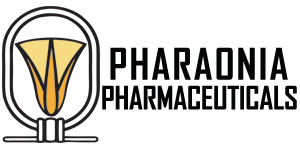

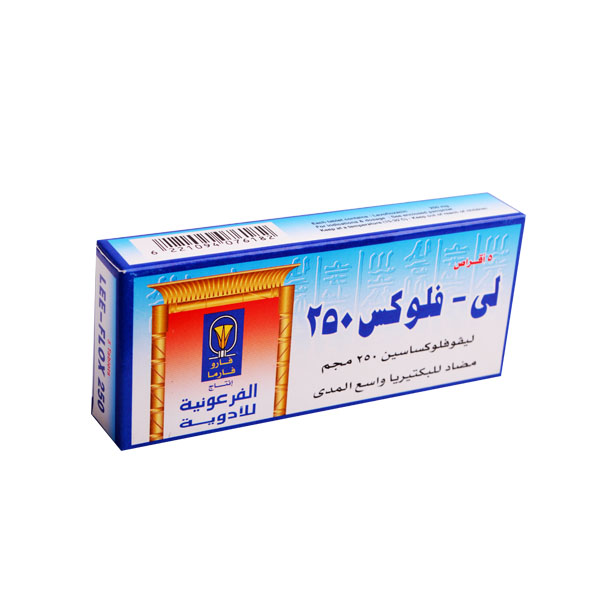

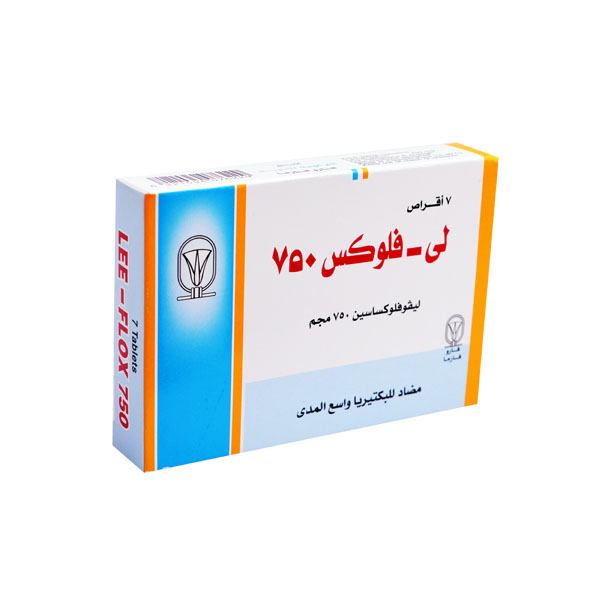
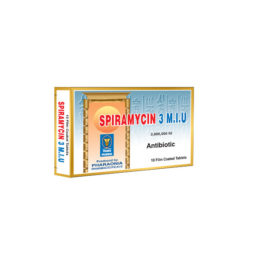
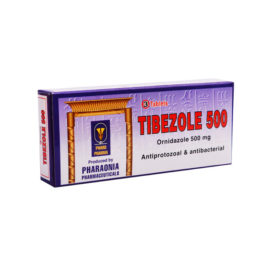
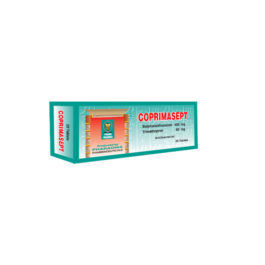

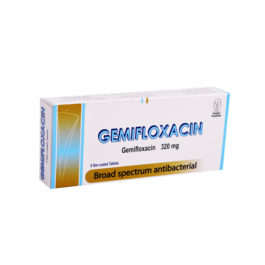
Reviews
There are no reviews yet.